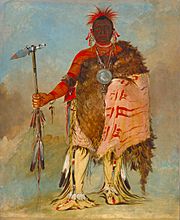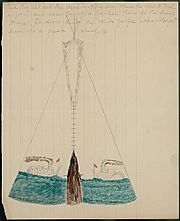Big Elk facts for kids
Quick facts for kids
Big Elk
|
|
|---|---|
| Ontopanga | |

A print of Big Elk
|
|
| Born | 1765-1775 |
| Died | 1846-1848 |
| Resting place | Bellevue Cemetery |
| Nationality | Omaha |
| Known for | A chief of the Omaha Indians, warrior, orator |
| Successor | Joseph LaFlesche |
| Children | Standing Elk (son) Mitain(daughter) Meumbane(daughter) |
Big Elk, also known as Ontopanga, was an important leader of the Omaha tribe. He lived from about 1765 to 1848. He was a principal chief for many years along the upper Missouri River. Big Elk was famous for a powerful speech he gave at the funeral of Black Buffalo in 1813.
Big Elk led his people during a time of big changes. They faced dangers from Sioux warfare and new diseases. European-American settlers were also moving onto their lands. He made alliances to protect his people. He believed a closer relationship with the United States was important for their future. Big Elk was ready to trade land for the promise of protection. However, he was often let down by the US government.
Contents
Big Elk's Leadership and Challenges

Big Elk worked hard to protect his people. They faced threats from European-Americans. But the biggest danger was warfare with the Sioux. The Omaha also suffered greatly from smallpox outbreaks. These diseases were brought by Europeans. Many Omaha people died because they had no natural protection.
Big Elk was an ally of the United States during the War of 1812. He worked with Lucien Fontenelle, a French Creole trader. Fontenelle helped by acting as an interpreter. Big Elk also sought help from the US to protect his tribe from the Sioux.
Forming Alliances Through Family
Big Elk admired some parts of European-American culture. He made important alliances through his daughters' marriages. Two of his daughters married well-known fur traders. His grandson, Logan Fontenelle, was of mixed heritage. He started working as an interpreter for the Omaha at age 15. This was for the US Indian agent.
The Omaha tribe had a patrilineal system. This means family ties were traced through the father. Because Logan Fontenelle's father was white, the Omaha did not consider Logan to be a member of their tribe. They saw him as a white man.
In 1843, Chief Big Elk chose his adopted son, Joseph LaFlesche, to be his successor. LaFlesche was a Métis fur trader. He had Ponca and French-Canadian roots. He lived with the Omaha for many years. Big Elk taught him the tribe's culture and the duties of a chief. LaFlesche became the principal chief from about 1853 to 1888. He was one of six chiefs who signed a treaty in 1854. This treaty gave away the last large parts of Omaha land. LaFlesche encouraged the Omaha to get an education. He also wanted them to adopt some European-American ways.
Logan Fontenelle became very important to the Omaha after 1853. He served as an interpreter during their land sale talks. Fontenelle helped the chiefs in Washington, D.C., during the final treaty talks. He was one of the seven people who signed the 1854 treaty. He may have signed because he was the only Omaha speaker who spoke English fluently. In this treaty, the Omaha gave most of their land to the United States. In return, they received yearly payments and goods. White people saw Fontenelle as a chief. But as mentioned, the Omaha did not see him as a tribal member. In 1855, he was killed by an enemy Sioux group while hunting.
Big Elk's Family Life
Big Elk was married to an Omaha woman. They had a son named Standing Elk. They also had several daughters, including Mitain and Me-um-bane.
Like many Native American tribes, the Omaha often welcomed new people. They adopted captives, orphans, and honored allies into their culture. Big Elk also arranged for two of his daughters to marry important fur traders. He wanted to make alliances to strengthen his family's connections. He believed these alliances could help his people.
Daughters' Marriages
In 1814, during the War of 1812, his daughter Mitain married Manuel Lisa. Lisa was appointed by the governor of the Missouri Territory. He was the US Indian agent on the Upper Missouri River. Lisa had been a well-known fur trader in Omaha territory for years. He had set up Fort Lisa in what is now North Omaha, Nebraska. After the war, Lisa went back to the fur trade. Mitain and Lisa lived together when he spent winters in Omaha territory. Lisa also had a legal wife in St. Louis.
Lisa and Mitain had a daughter, Rosalie, and a son, Christopher. In 1819, Lisa took Rosalie to St. Louis for schooling. But Mitain refused to let him take Christopher. Big Elk supported his daughter in this decision.
Around 1823–24, Big Elk's daughter Me-um-bane married Lucien Fontenelle. He was from a rich French Creole family in New Orleans. He set up a trading post near what is now Bellevue, Nebraska. He lived there full-time. They had five children together. Their first son, Logan Fontenelle, was born in 1825. He became an interpreter for the Omaha. He started working for the US Indian agent after his father died in 1840.
Some historians believe Logan Fontenelle was elected a chief in 1853. He was documented as an interpreter for the chiefs during land sale talks. In January 1854, 60 Omaha chiefs met to talk with Agent Greenwood. Later that year, Fontenelle went to Washington, D.C., with seven chiefs. They went to finish a treaty with the United States. He was one of two interpreters. He was the only Omaha speaker who could read and write English. The Omaha gave up most of their land. In return, they received yearly payments and goods. They also moved to a reservation in what is now northeastern Nebraska.
Joseph LaFlesche, Big Elk's Successor
Big Elk formally adopted the trader Joseph LaFlesche as his son. This made LaFlesche part of the Omaha tribe. LaFlesche's mother, Waoowinchtcha, was Ponca. She was also a relative of Big Elk. LaFlesche's father was Joseph LaFlesche, a French-Canadian fur trader. He worked for the American Fur Company. He had worked with the Omaha and other tribes for many years. The younger LaFlesche started going on trading trips with his father at age 10. He began working for the AFC at age 16.
In 1843, Big Elk chose LaFlesche to be his successor. LaFlesche seriously studied the tribal ways and customs. He prepared to become a chief. LaFlesche joined the tribal council around 1849. This was after he settled with the Omaha at the Bellevue Agency.
LaFlesche was very well-educated and cultured. He married Mary Gale. She was the daughter of an American surgeon and his Iowa wife. LaFlesche served as the principal chief of the Omaha from 1855 to 1888. This was a time of big changes for the tribe. They moved to a reservation. He encouraged the Omaha to learn English and to accept Christianity. He also wanted them to adopt some European-American ways.
He and Mary encouraged their children to get an education. Several of them went to schools and colleges in the East. They became important leaders among the Omaha. One daughter became the first Native American woman physician. Another became an activist for Omaha rights. A third managed the tribe's money. After Mary died around 1855, LaFlesche married Tainne, an Omaha woman. Their son Francis La Flesche (born 1857) also got an education. He worked as an ethnologist for the Smithsonian Institution. He worked closely with anthropologist Alice Fletcher. He wrote books and research about the Omaha and the Osage. He helped save their traditions.
See also
 In Spanish: Big Elk para niños
In Spanish: Big Elk para niños
Images for kids





